The Intelligent Way to Build: Why SIPs Beat 'Cheaper' Every Time
Discover why SIPs are the smartest investment in building—delivering precision, performance, and long-term value that..
Seriously? Construction, the cornerstone of modern civilization, remains stuck in a time warp, clinging steadfastly to outdated practices like relics from the past. In fact, we have won the “achievement” of being the most stagnant industry over the last 150 years. In a world where technological advancements have propelled industries forward, construction remains alarmingly stagnant, entrenched in centuries-old methodologies. Every other industry has long surpassed construction from cars to trains to planes. Starting with the Wright Brothers’ inaugural flight in 1903 and then Neil Armstrong’s iconic moonwalk in 1969, humanity has achieved extraordinary milestones. Yet, despite these feats, the construction industry continues adhering to antiquated norms. Even in 2024, we are still designing and building using technology that is a century and a half old—stick-framed construction. But let’s confront the reality: 150 years of doing the same thing is far too long. It’s time to quit stick-ing in the past. It’s long past time for a change.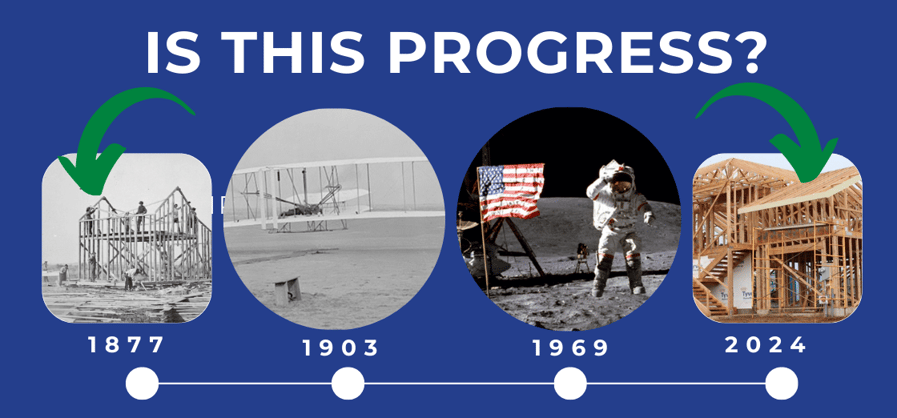
Let's address the core issues—stagnant productivity, budget overruns, skilled labor shortages, and environmental impact—these are the prevailing challenges within the construction industry. Despite these persistent hurdles, architects and builders remain entrenched in conventional building practices. Why? Because we know what to expect. However, the hurdles above are forcing overdue change, that other industries embraced long before construction has. Stagnant productivity hampers economic growth and impedes the adoption of more efficient methods. Budget overruns and delays have become all too common, straining project finances and timelines. Additionally, the industry continues to face a significant shortage of skilled workers, further complicating project execution using 150-year-old site framing methods.
The environmental toll is also undeniable—the construction sector contributes to 40% of global carbon emissions, necessitating a shift towards sustainable practices. Balancing environmental concerns with efficiency is now a critical consideration for industry professionals. So, why do so many continue to rely on outdated (much less energy-efficient, and more costly) methods in the face of these challenges?
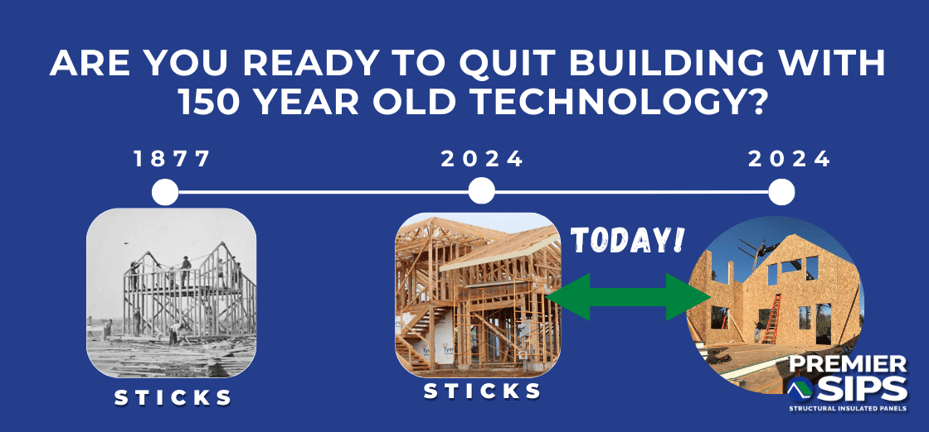
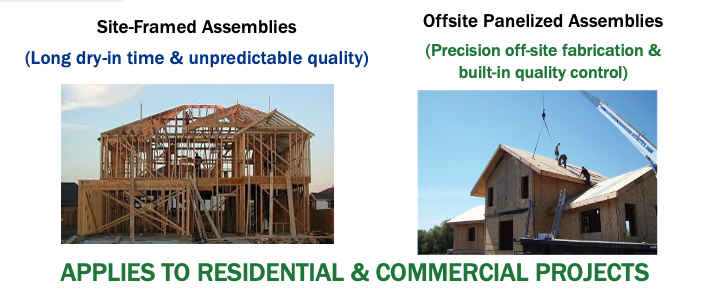 Premier SIPS, with a legacy dating back to 1985, has been leading the charge in this building transformation. These factory-fabricated panels offer more than just simplified offsite construction processes; they provide tangible benefits for general contractors, architects, developers, building occupants, and owners. By lowering costs, shortening construction timelines, reducing waste, and creating healthier indoor environments, SIPS are revolutionizing the way we build. Let's explore how SIPs can transform your building projects in comparison to stick-framed construction.
Premier SIPS, with a legacy dating back to 1985, has been leading the charge in this building transformation. These factory-fabricated panels offer more than just simplified offsite construction processes; they provide tangible benefits for general contractors, architects, developers, building occupants, and owners. By lowering costs, shortening construction timelines, reducing waste, and creating healthier indoor environments, SIPS are revolutionizing the way we build. Let's explore how SIPs can transform your building projects in comparison to stick-framed construction.
Stick framing versus SIPs—let's settle this once and for all. On one side, you have traditional stick framing, a relic of the past, plagued by structural limitations, insulation woes, and air leakage nightmares. On the other side, you have Premier SIPS, a modern innovation of engineering, offering unparalleled strength, energy efficiency, and airtightness. Seriously, it's a no-brainer. Let’s break it down…
1. Structure:Stick Framing: Traditional stick framing relies on assembling individual wooden pieces to create a building's frame. While commonly practiced for decades, stick framing poses challenges regarding structural integrity. It often requires additional bracing and support to withstand environmental factors and natural disasters. It also requires site measuring and cutting of each component and multiple trades to complete the envelope frame/insulation/sheathing assembly. Further, today’s green lumber is not as structurally consistent as it used to be. Lumber quality is often inconsistent from piece to piece and can be bowed or slightly off-plane. This requires more shimming or other adjustments that has a trickle-down effect for other drywall and finish trades when walls are not straight and plumb.
SIPS: SIPs offer a revolutionary approach to structural integrity and engineered precision. These factory-fabricated panels are structural grade facings laminated to a solid engineered insulation core. The full structural load and strength that SIPs provide delivers unparalleled strength, capable of supporting heavy loads and resisting damage from natural disasters like earthquakes, hurricane-force winds, heavy coastal rain, and wildfires without the need for additional bracing. Further, the engineered facings are straight and plumb every time.
2. Insulation:Stick Framing: Insulating stick-framed structures typically involves adding insulation to the cavities between wooden studs. However, this method often results in thermal bridging, where heat easily transfers through the studs, reducing overall energy efficiency. Most cavity insulation also does not carry the same thermal values, and the values degrade significantly over time as the product weighs down. Spray-in cavity wall insulation options are extremely expensive and are most often not environmentally friendly. Stick frame cavity wall insulation also requires an additional sub-contractor to coordinate, additional time, associated labor costs, and materials to achieve desired insulation levels.
Adding to this many states are adopting new 2021 IECC energy codes which require an additional layer of continuous insulation around the exterior of a stick-framed structure to combat the energy transfer through stick/stud walls (Colorado, California, Oregon, and Washington, with many others with implementation dates coming soon). This is a new significant added cost that Architects and Contractors will need to weigh when choosing to stick with site-framed assemblies.

SIPs: SIPs excel in insulation efficiency, thanks to their solid foam core that creates a continuous thermal barrier. Unlike stick framing, SIPs minimize thermal bridging, ensuring superior energy efficiency and reducing the need for additional insulation. The engineered insulation also does not degrade in thermal value over time, it does not contain harmful chemicals and is 100% recyclable. This streamlined approach not only saves time and labor but also enhances the building's overall performance and comfort.
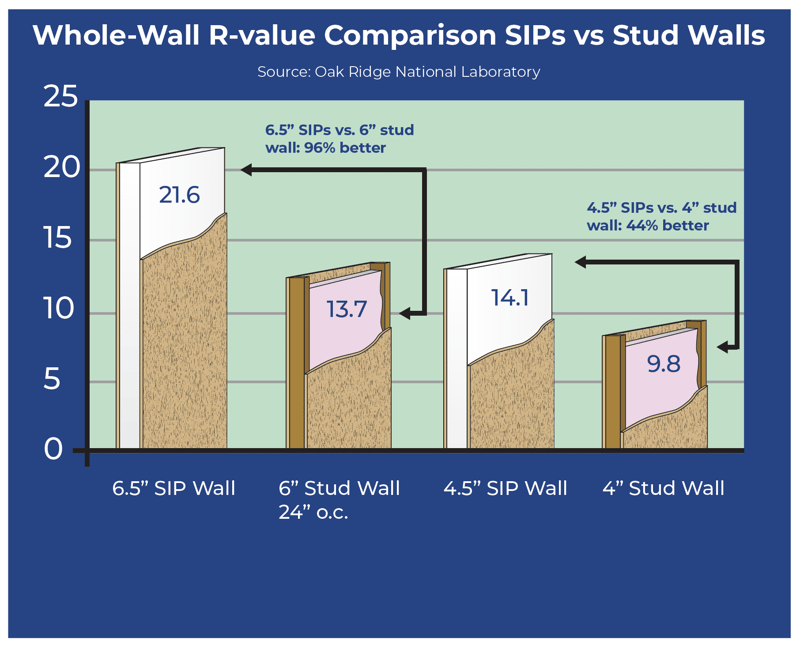
3. Air Barrier:
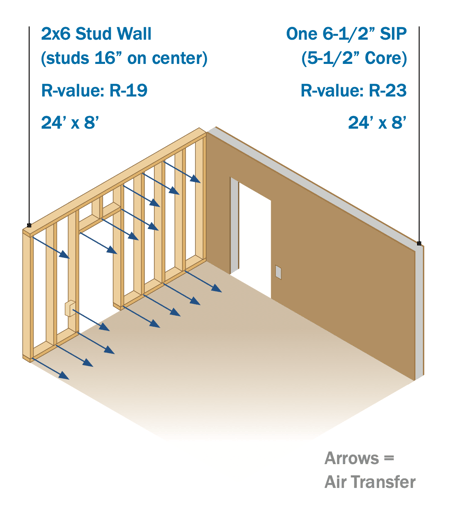 Stick Framing: Traditional stick-framed structures often struggle to maintain air tightness due to numerous joints and potential gaps between framing members. This can lead to significant air and moisture leaks, compromising energy efficiency and indoor air quality. With out-dated stick framing assemblies, owners (and often builders in the warranty period) continually battle to manage air and moisture problems, including mold growth and structural decay.
Stick Framing: Traditional stick-framed structures often struggle to maintain air tightness due to numerous joints and potential gaps between framing members. This can lead to significant air and moisture leaks, compromising energy efficiency and indoor air quality. With out-dated stick framing assemblies, owners (and often builders in the warranty period) continually battle to manage air and moisture problems, including mold growth and structural decay.
SIPs: SIPs act as a seamless air barrier, minimizing joints and tightly sealing the building envelope. With few opportunities for air leakage, SIPs prevent heat loss or gain, ensuring consistent indoor temperatures and reducing the risk of moisture-related issues. By promoting a healthier indoor environment, SIPs contribute to the long-term durability and sustainability of buildings.
4. Construction Simplicity:Stick Framing: Stick framing often involves complex assembly processes, requiring precise measurements and skilled labor for each component. The construction timeline is elongated as multiple crews work on different aspects of the frame, leading to potential delays and coordination challenges.
SIPs: SIPs simplify the construction process significantly. These factory-fabricated panels arrive at the site ready for installation, reducing the need for on-site cutting and trimming. With fewer components to assemble, SIPs streamline the construction timeline, allowing for faster and more efficient building completion. Additionally, the simplified installation process reduces the reliance on skilled labor, making SIPs an attractive option for projects facing labor shortages.
5. Sustainability:Stick Framing: Traditional stick framing relies heavily on timber, leading to deforestation and habitat loss. Additionally, the manufacturing and transportation of individual wooden pieces contribute to carbon emissions and environmental degradation. Wood waste is sent to the landfill. For example, for a typical residential home construction waste, there is on average 8,000 lbs/50 Cu. Yds. And for commercial projects, the waste is even greater.
SIPs: SIPs offer a more sustainable alternative to traditional stick framing, manufactured with rapidly renewable resources. SIPs reduce the reliance on timber while providing superior structural integrity and energy efficiency. Offsite construction nature of SIPS optimizes materials & reduces waste in a factory setting resulting in 30% average savings on job site waste disposal costs. Furthermore, the energy-saving properties of SIPs contribute to reduced operational energy consumption over the lifetime of the building, further enhancing its sustainability credentials.
Sticks vs. SIPS: A Comparative Analysis, Exposing the Real Value in Cost Savings
And last but not least, the 2023 Inflation Reduction Act (IRA) provides tax incentives for residential, commercial, and multifamily projects. While these incentives are aimed at promoting economic growth and development, it's worth noting that they favor innovative building methods over outdated practices. Is the IRA offering these incentives for stick frame construction? Not a chance. But for those embracing the future with SIP construction, the benefits are clear.
While stick framing has been the conventional choice for generations, its limitations are becoming increasingly evident in the face of modern challenges. It’s time to redefine the way you design and build. Since 1985 Premier SIPS has been at the forefront of product development and is now the leading SIP manufacturer in North America. Our product comes with a 20-year warranty because we know that it will stand the test of time. As the construction industry strives for innovation and sustainability, let’s focus on building for the future and quit stick-ing around. Contact us today to learn more about SIPS.

Discover why SIPs are the smartest investment in building—delivering precision, performance, and long-term value that..
Lumber tariffs driving up costs? SIPs cut lumber use by up to 80%, lower labor needs, and deliver stronger, faster, more..
Discover how Structural Insulated Panels outperform stick framing by cutting energy use 40–60%, reducing waste, and saving..
High-performance buildings start with better systems.
Premier SIPS deliver a building envelope that outperforms traditional framing in efficiency, strength, and long-term durability. If your project demands higher performance and greater predictability, let’s talk.